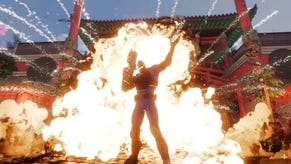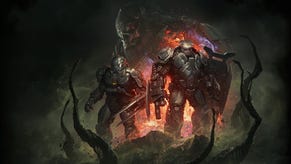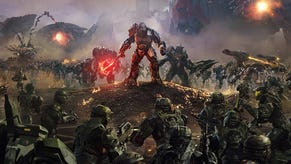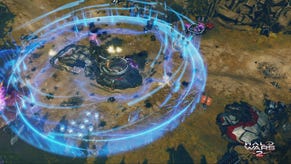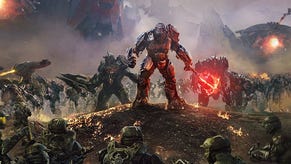Halo Wars 2 Review
Is this RTS good for beginners? We have just the person to answer that question.
This article first appeared on USgamer, a partner publication of VG247. Some content, such as this article, has been migrated to VG247 for posterity after USgamer's closure - but it has not been edited or further vetted by the VG247 team.
If you're looking for an expert RTS player's viewpoint on Halo Wars 2, I'm afraid you've come to the wrong review. I'm actually an RTS novice, and am evaluating this game very much from a beginner's perspective.
Naturally, I don't think this renders my review pointless. Indeed, I feel it's a true test of something that Microsoft claims about this latest addition to the Halo universe – that it's a very accessible RTS designed to be easy to pick up and play for those new to the genre.
I First Played RTS Games in the 90s
Going into the game, I had few expectations, but did have one or two prejudices. It's not like I haven't ever played an RTS before: I tried giving the Command and Conquer series a whirl back in the 90s, and have also attempted to play Starcraft II on several occasions. However, my efforts were unsuccessful. I just found their learning curve a little on the steep side, and it didn't take long before frustration set in as I repeatedly lost game after game.
The other issue was that I just didn't find them particularly compelling to play. Had I done so, I'd have felt more motivated to invest time into learning their intricacies. Instead, I just ended up feeling like they weren't for me; that despite being intrigued by them in concept, my more action-oriented gaming brain was just not suited to their more cerebral strategic challenge.
That was very much front of mind when I first booted up Halo Wars 2. I expected an uphill battle; doubly so because of playing it with a gamepad, rather than a mouse and keyboard. Turns out my fears were unfounded – at least in terms of the basics. Halo Wars 2 kicks off with a tutorial that makes learning the ins and outs of the game's fundamentals a breeze. By the end of the tutorial, I actually felt confident approaching the game – despite still feeling trepidations about how effectively I could keep all my resource-management plates spinning when I was finally thrust into combat.
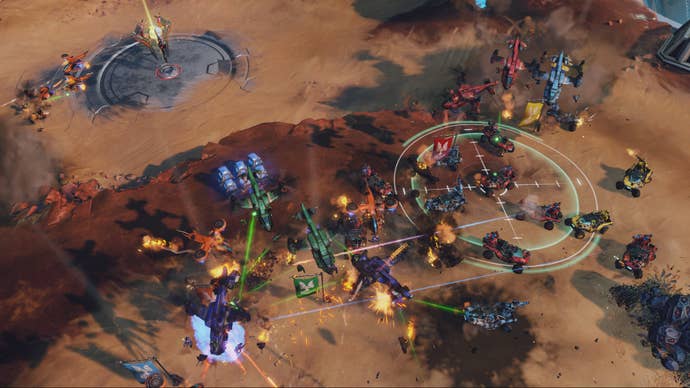
It didn't take long to find out. The campaign opens with some spectacular cinematics that articulate its somewhat straightforward storyline. The game is set in the months following Halo 5: Guardians, and focuses on the United Nations Space Command ship, the Spirit of Fire, led by Captain James Cutter. Having snoozed through the last 28 years in stasis, the crew awakens at the Ark to find a distress beacon signaling them from its surface. Troops are sent to investigate, but what they find isn't good news. A breakaway Covenant faction called the Banished, led by psychotic Brute Atriox, is attempting to take control of the Ark, setting the scene for a confrontation between the Spirit of Fire's forces, and Atriox' overwhelming hordes.
The first of the game's 12 missions takes the form of a prologue in which you guide a warthog across a linear map, stopping at waypoints to activate objectives and destroy barriers. It's very easy going, and seems to exist more to set up the main storyline than to provide any kind of meaningful challenge.
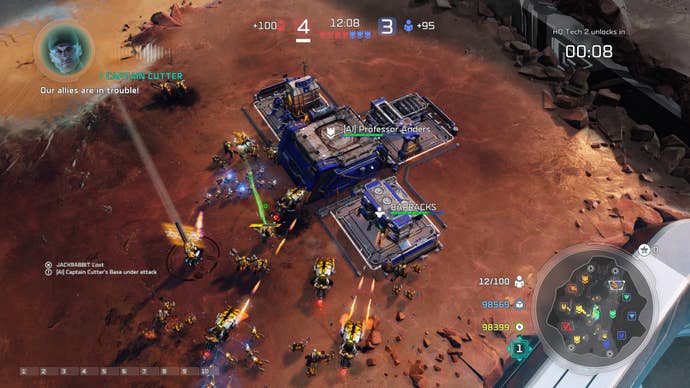
The action ramps up in the second mission, however, and the proceedings begin to feel a little more like a proper RTS as you march a small group of allies across the battlefield, laying waste to the light Banished ground force resistance. Again, there are simple objectives to follow, which eventually lead to a location where you set up your first base. Once the main building is finished, you then construct additional annexes that generate energy and supply resources. Barracks and installations can also be erected that, assuming you garner sufficient resources, are able to spawn combat units and vehicles to supplement your army.
It's pretty straightforward stuff, and isn't a far cry from the fundamental design of the Command and Conquer games that I played so long ago. What's different now, however, is just how clearly Halo Wars 2 articulates its objectives. As you progress through missions, different targets and goals are highlighted, either via dialogue or cut scenes, so there's no mystery about the requisite course of action. The game even deftly weaves hints and tips into its comms chatter to ensure that the player not only knows what to do, but also understands how to deal with the enemy threats. Thanks to this excellent presentation, I managed to muddle my way through to the campaign's mid-point with relative ease. However, as I hit the campaign's latter stages, I started to become unstuck.
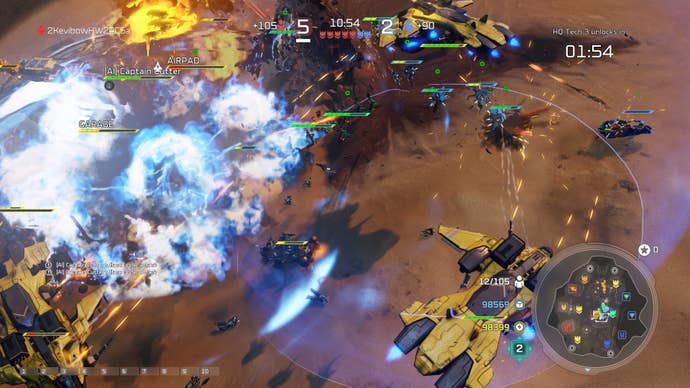
Control Complexities
Later missions become increasingly complex, and require the player to fight multiple battles on numerous fronts while managing several bases simultaneously. The game's basic controls are quite intuitive, but unfortunately its more advanced actions can feel a little clunky to execute, especially in the heat of battle. Vital commands, such as scrolling around the map, picking out specific units and ordering them to attack certain enemy targets, or highlighting bases and installations and using the wheel menus to choose which units to build can be quite fiddly. And maneuvering squads and vehicles to just the right spot can sometimes take longer than it seems it should. As a consequence, I wasn't able to issue commands quickly and efficiently enough, resulting in my forces getting wasted by the Banished hordes, and me feeling very frustrated. I knew what I needed to do; I just couldn't do it fast enough. Still, I stuck with the game until I eventually hard-wired the control scheme into my brain, but it was a learning process that felt more like work than fun.
Once I'd gotten my head around the control scheme and was able to command my forces to the requisite degree of finesse, I started to enjoy myself again. The last few missions are tough, and it required multiple tries to beat them, but it felt very rewarding and satisfying when I finally managed to reach the game's conclusion, despite the ending itself being rather disappointing.
Stepping back and looking at it objectively, I believe Halo Wars 2's campaign is indeed well suited for beginners. It does a great job teaching you how to play it, and the difficulty curve over the first few levels is nicely progressive. It only gets tricky later on when you really need to really master the complexities of the controls, but I think that's something that would challenge any player, regardless of their prior RTS experience. And while the campaign is a little on the short side (it took me about nine hours to work through it – others have reported completing it in as little as six), what it does do is set you up really nicely for the multiplayer modes.
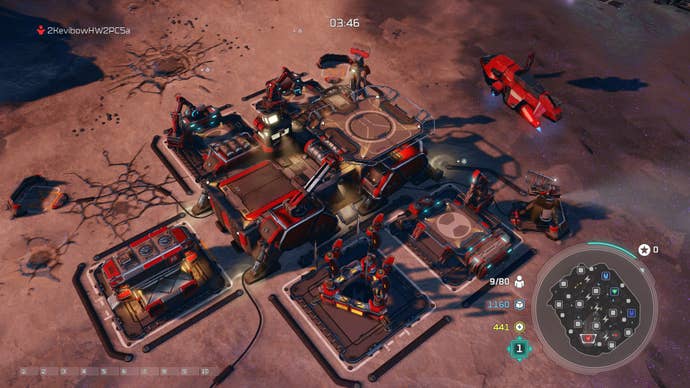
Halo Wars 2's Multiplayer
The process of finishing the campaign earned me a stack of card packs for the game's Blitz mode, and that's where I started when I finally plucked up the courage to tackle Halo Wars 2's multiplayer component. This stripped-down, fast-moving game involves designing a deck of cards, and then taking it into battle against other players. Putting together a basic deck is quick and easy – choose a leader, and then simply compile a list of cards from your collection that represent the units, heroes, and abilities that you want to use.
Once a game begins, there are three nodes to attack on the map, and controlling these is vital to score the points that you need to win the game. Energy is generated automatically as the game progresses, and additional energy supplies are also dropped onto the map at regular intervals that can be picked up by your units and added to your total. Cards are played using the energy you garner, and the more powerful the unit or effect it generates, the more expensive it is to use.
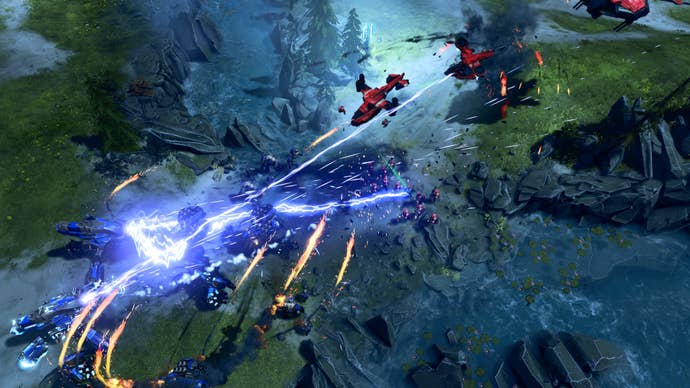
Games unfold very rapidly, and you need to be quite quick on the trigger as you utilize your energy to play units and get them involved in the battle as rapidly as possible. Units can be deployed anywhere you have line of sight, and I often found myself flitting between disparate units, reinforcing my squads as I guided them around the map, attacking and defending the trio of control points.
Blitz is very easy to pick up and play, but learning its strategies took me quite a few games, and I suffered several losses in a row before I finally figured out how to utilize my deck to its best potential. I started out with a rush deck containing plenty of low-cost units that I could deploy quickly and efficiently, which were supported by a couple of high-cost abilities that I'd use to attempt to thwart my opponent's late-game strategies. Basically, this deck enabled me to spool out an early lead, and then dig in to defend what I controlled as my opponent's forces grew in strength. My tactics didn't work all the time, but I did manage to win a few games using this method – especially once I began to understand the passive effects of my units, so that I could start using them a little more effectively.
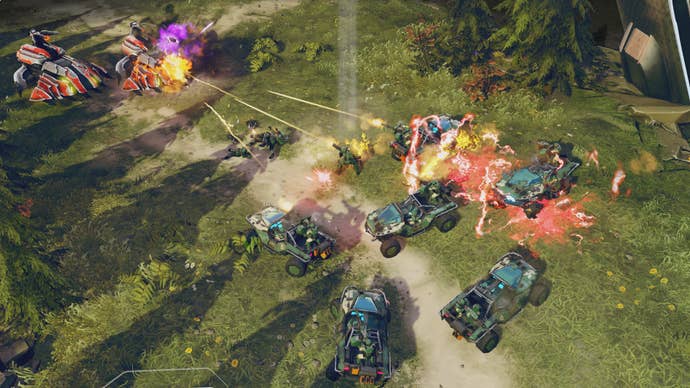
While my efforts haven't exactly been a success, I've nevertheless really enjoyed playing Blitz, and the more I learn about the game's deeper strategies, the more I'm looking forward to building new decks to better match my playstyle. My only problem is that while I have a reasonable selection of cards, I don't quite have the range to really play around with decks in the way that I'd like – which means slowly grinding for more cards, or spending real money to bolster my collection. Either way, I find it a little frustrating for a premium-priced game to have this kind of mechanic. I could understand it if Blitz was a standalone free-to-play release like Hearthstone, but since it's part of a premium game, it just seems somewhat incongruous.
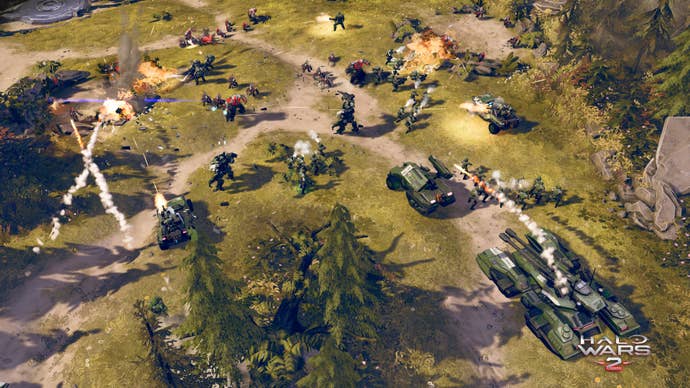
Fortunately, the rest of the multiplayer modes don't have this kind of limitation, and can be played freely. Skirmish is a straightforward solo or co-op fight against AI opponents, while Strongholds is a timed game in which players attempt to control the bases that are situated around the map to win. Domination involves building bases and attempting to take over nodes on the map to out-score your opponent, and Deathmatch pits each player's army against the other in a fight to the death.
I've mainly concentrated my efforts on Skirmish, playing against the AI to really learn the ropes. Despite losing games initially, I've slowly been able to develop the tactics required to outwit my opponent – at least, occasionally – and that progress has felt quite rewarding. The only complaint I have is the same as the one I outlined while playing the more challenging campaign missions – which is that the controls can get quite fiddly in the heat of battle when you’re trying to manage multiple units on multiple fronts. That can make the game a little frustrating until you're completely familiar with the controls, but fortunately it's not an insurmountable issue, assuming you're willing to put in the time and effort to learn the intricacies of the interface.
Control issues aside, playing Halo Wars 2 has been a surprisingly enjoyable and satisfying experience. Coming in as an absolute beginner, it's taught me the basics of RTS strategies, and increased my confidence sufficiently to try multiplayer battles. I clearly still have plenty to learn in terms of the game's deeper tactics, but that'll come from investing further time into the game – which is something I'm looking forward to.
InterfaceIt's easy to pick up the basic controls, but the more advanced commands require time and effort to master.
Lasting AppealThe fairly short campaign won't keep you busy for long, but fortunately the multiplayer side of the game offers plenty to get your teeth into.
SoundA great-sounding, Halo-esque score accompanies the action.
VisualsHalo Wars 2's miniature forces are very nicely detailed, and the cinematics are marvelous.
ConclusionHalo Wars 2 is a very accessible RTS that's easy to pick up and play, but becomes increasingly complex as you get to grips with its more advanced commands. Assuming you're willing to invest the time and effort to truly master its intricate controls, the game offers plenty to get your teeth into. The campaign is a little short, but the multiplayer components are varied and robust - even if the really entertaining Blitz mode is soured somewhat by its microtransactional focus.

